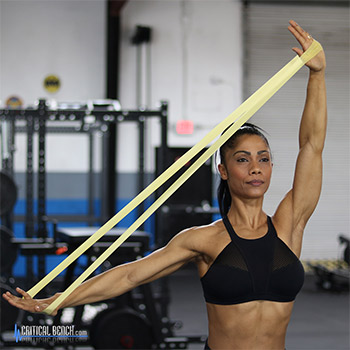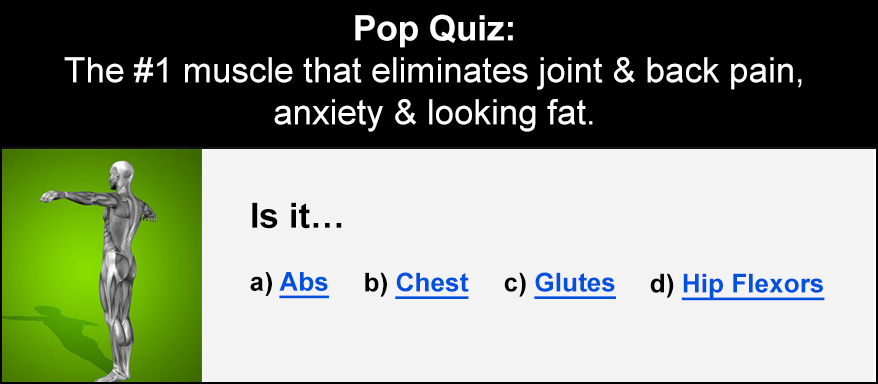
The shoulders are one of the most common causes for complaint in both athletes and the population at large. Since everyone’s susceptible to injury here, we’re going to discuss shoulder mobility – why it matters, and how to get some.
If you’re sick of achey shoulders, reduced movement, or poor exercise performance then read on. Today’s article is going to save your shoulders, upper back, and neck from a lot of hassle!
Injury Prevention
The point of shoulder mobility – first and foremost – is to keep your shoulders healthy. We aren’t just mobilising the shoulders for fun – we’re working towards a stronger and healthier shoulder.
This comes from having strength and control in all ranges of the shoulder joint. If you’ve got impingements and restrictions in the shoulder, you’re not going to be able to develop strength and safety in all ranges.
Simply put, a mobile and strong shoulder is how we reduce injury risk, and poor mobility in any range can drastically increase injury risk. We recommend mobilising your shoulder to keep them safe – especially since 43% of athletes complain of shoulder pain, and likely as many in the normal population.
Your shoulder has the largest amount of range of any joint in the body by nature, and this means you’ve got some work to do to keep it mobile and strong.
Longevity and Mobility
Aside from keeping you pain-free in the short-term, mobility is an investment in your long-term health and wellbeing. Proper joint-freedom is something we look for when assessing the long-term risk of a joint.
As we age, it’s easy to lose mobility in joints through becoming inactive or losing muscle mass that controls range. Properly exercising the shoulder with a combination of mobility and strengthening is essential to keep the joint strong and stable, preventing muscle waste or loss of control.
At the very least, keeping yourself moving through full ranges helps you maintain them for the future. The body works on a principle of “use it or lose it” – if you’re not moving through full range you’ll soon be unable to.
This is what’s at stake when doing mobility work, and you can only protect range through use and strengthening. In the fight against aging, the combination of flexibility and control/strength are what determine what you keep and what you lose.

Postural Changes
Posture changes during aging, too, and it’s far too common to see poor upper body posture in those who have aged without activity. Of course, there are other factors, but poor positioning in the upper body is one of the contributors.
Binding the shoulder girdle forward through poor movement and inactivity in the shoulders draws the body into a “rolled forward” position. The shoulders interact closely with the scapular region and the upper back, which are also key players in this process.
Poor mobility in the shoulders, excessive forward binding in the shoulder joints, and scapular inactivity all add up to produce this poor posture. Learning to open up the chest, roll the shoulders back, control the shoulder blades, and extend the upper back all play very closely together.
Good shoulder mobility extends beyond the shoulders themselves into these linked regions and helps to develop basic control and movement capacity in these crucial areas. Poor movement here is a real risk as we age, from tension headache risk to long-term postural compromise!
Strength and Performance
When we work on control and mobility in the shoulders, strength and performance in the region can improve more sustainably and effectively. Note that this isn’t the same as causing progress; it’s simply setting the foundation for it.
Despite what some people believe, improved mobility doesn’t mean improved performance by itself. It does, however, increase the amount of effective loading we can do and helps to develop control and stability in the joint through better movement control.
We already know that stability is a huge deal for maximum strength, and that’s something we see in good mobility training. On top of this, it offers a way of keeping th shoulder joint health during repetitive use and loading, where it might otherwise have a lower cap to effective, safe training volume.
This is especially true when we consider the associated structures like the scap and the upper back, as mentioned above. It’s not uncommon for improvements in chest, shoulder, and upper back exercises as the functional range of the muscles improves and their co-ordination is practiced.
Getting good mobility work in isn’t just for mobility and injury risk, it’s a chance to build quality of movement and active use of muscles. It’s a chance to practice the posture and movement/activation we’re looking for in key exercises – whether that’s a pull up, bench press, or military press.
Longevity is the key to amazing performance and effective mobility training contributes in more than way!
Keys To Good Shoulder Mobility
There are a few keys to good shoulder mobility that we’re going to go through. There are hundreds of ways you could work on your shoulder mobility so we’re going to discuss principles and some of our favourite examples!

Get Moving First
Your stretching and mobility should always start with light movement to raise the body temperature and kickstart the natural self-lubricating process of the joints. This just ensures you’re not stretching cold muscles or tendons, keeping your blood flow up and promoting recovery/nutrient delivery.
This should also be performed with the intention of good movement in mind- it’s a way of starting the process and freeing up some movement. It’s not going to do much alone, but it prepares everything for movement.
This should also be performed before a workout – lots of movement in the shoulders such as raises, rotations, and presses with light weight are great choices. The idea is just to get the movement in and ‘turn the muscles on’.
Move Through Full-Range in 3 Dimensions
The shoulders – like other joints – need to be comfortable in every direction they’re designed for. When it comes to shoulders, that’s every direction.
Don’t just focus on stretching into extension, for example. Moving well in every direction will bulletproof the shoulders and ensure they’re prepared to handle load in every direction. This means practicing rotation movements, stretching both forward and backward, and including every muscle group in your training focus.
It’s easy to focus on just one side – or just your weak points – but a comprehensive approach keeps everything healthy.
Add a Small Amount of Weight to Your Stretches
We have to come back to the shoulder dislocate because this is perhaps the best, or most common, example of a quality weighted stretch. Adding a small amount of weight forces you to be conscious and active with your range, as well as strengthening the small stabiliser muscles around the joint.
The range of this exercise is pretty much maximal, and it ensures that you’re mobile, active, and strong around this range.
From here, you should look at other forms of stretching that introduce a weighted component – or implement an active portion. Pilates is one example of this, using bodyweight resistance, while VAL slides and similar exercises offer the same kind of quality stretching-strength hybrid.
Finally, work towards longer slow-eccentric exercises. These are the logical conclusion of weighted stretching, especially when combined with active pauses. They offer a way of increasing shoulder mobility with something like light, slow-eccentric shoulder extension and raises.
These ensure control and allow you to reach greater end-ranges. Naturally, take your time progressing here and be willing to use light weights and develop slowly. Joints take time to condition, so be patient to stay safe!
Practice Control and Range
When you come to exercise and workouts, focus on applying the same full-range, controlled, slow movements we’ve discussed here. Proper focus on control and quality build long-term strength and safety.
You should be focusing on moving with good technique – controlling the muscles of the upper back, positioning the shoulder blades appropriately, and balancing your training for each direction to keep muscle development even.
These are small things that pay off in the long term and they ensure that you don’t slide back into poor habits and shoulder problems. They are another form of investment in the future – and once you’re in the habit of practicing full-range, controlled strength training, you’re not likely to lose the mobility or control!
Final thoughts
The shoulders are tricky – they have a ton of range by nature but that also opens them up to significant risks. Good care for your shoulders means long-term health and performance, but it comes at the cost of smart training and mobility work.
The combination of flexibility, strength, and control is how we develop better mobility. There are benefits to almost everything you do with your shoulders – from posture to performance to pain-freedom.
If you follow the principles we’ve set out here, you’re going to set yourself up for low risk and high reward. Proper mobility may only take 5-15 minutes a day and it is one of the best investments you can make in yourself!
If you’re struggling, focus on getting it in where you can and focusing on the easy wins. 5 minutes here, 2 minutes there, whatever you can fit in.







